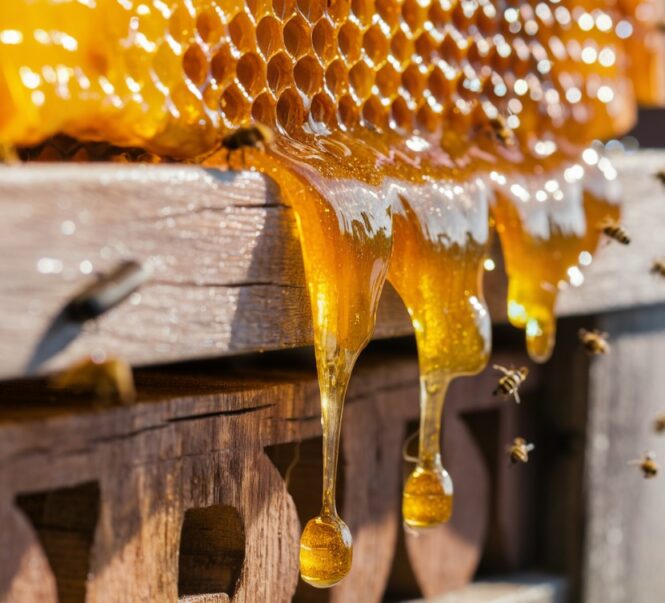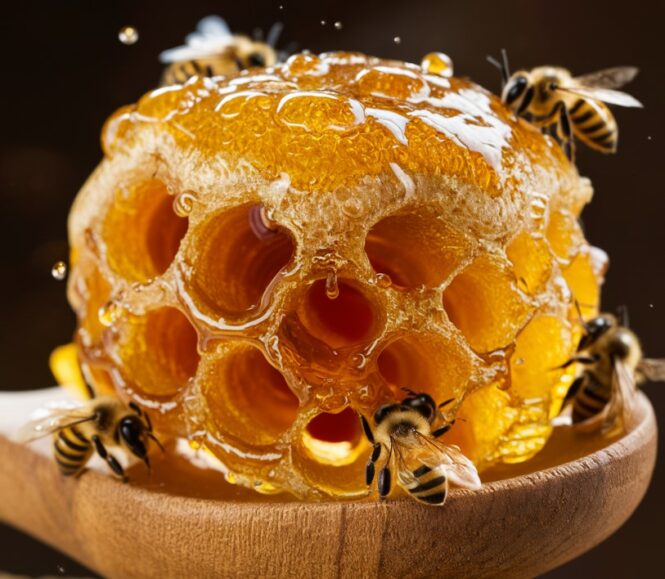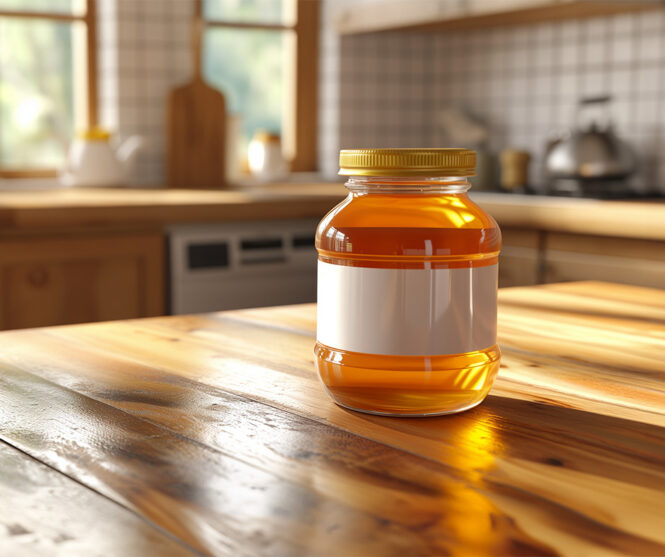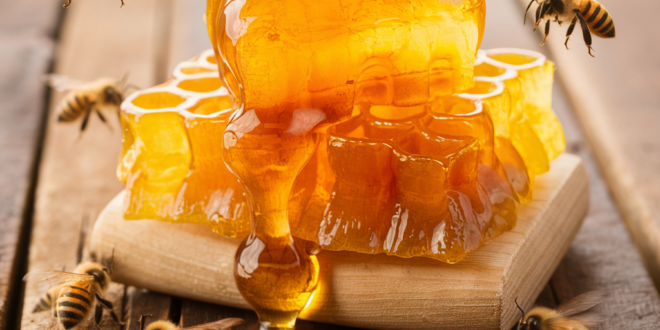Imagine the last time you indulged in a warm slice of bread, generously drizzled with golden honey. The moment when that delightful sweetness melted on your tongue was nothing short of blissful. But, how confident are you that what you enjoyed was pure honey and not an elaborate imitation?
The prevalence of honey fraud can leave individuals confused and cautious about what they consume. With the alarming rate of honey adulteration, knowing how to distinguish pure honey from its counterfeit rivals is not merely a helpful skill; it’s essential for health and wellness. Understanding the traits of genuine honey ensures that its rich flavors and myriad benefits are truly enjoyed. Hence, embarking on this journey of honey knowledge can elevate one’s culinary experience and safeguard against harmful substances in diet.
Key Takeaways
- Pure honey is derived from the natural nectar of flowers and has health benefits.
- Knowing how to spot adulterated honey can save consumers money and promote better health.
- It is vital to understand the differences between pure and fake honey.
- Simple at-home tests can help verify honey’s purity with minimal effort.
- Careful label reading assists in identifying high-quality honey products.
Pure Honey
To understand pure honey, one must differentiate it from fake honey. The distinctions help consumers to identify genuine products and ensure they are getting the nutrition and taste they expect.
Defining Pure Honey vs. Fake Honey

Pure honey is defined as honey that has not been adulterated. It contains no added sugars, such as corn syrup or glucose, and comes exclusively from the nectar gathered by bees. In contrast, fake honey often consists of various sweeteners and other substances that dilute its natural qualities, undermining honey purity.
Characteristics of Pure Honey
Acknowledging the pure honey characteristics is vital for honey lovers. Authentic honey exhibits a thick, viscous texture and rich, complex flavors that reflect the flowers from which the nectar was sourced. Additionally, pure honey tends to crystallize over time due to its natural glucose content. This crystallization does not indicate spoilage; instead, it is a sign of genuine honey quality.
| Characteristic | Pure Honey | Fake Honey |
| Texture | Thick and viscous | May be thin or overly syrupy |
| Flavor | Rich and diverse, dependent on floral source | Often lacks depth or has artificial taste |
| Crystallization | May crystallize naturally over time | Rarely crystallizes; often stays liquid |
| Additives | No additives or sweeteners | May contain various sweeteners and fillers |
Why Honey Adulteration Happens
The issue of honey adulteration stems largely from economic motivations within the honey production industry. As consumer demand rises globally, the supply of pure honey sometimes falls short, creating scenarios where producers might resort to mixing honey with cheaper substances. Understanding the Economics of Honey Production reveals how financial pressures lead to this practice.
The Economics of Honey Production
In the competitive honey market, profitability is crucial. When prices for pure honey increase, some producers may choose to cut corners by incorporating less expensive alternatives. This practice not only dilutes the quality of the product but also raises significant concerns about authenticity. The financial incentives to maximize yield while minimizing costs can compromise ethical production standards, making it vital for consumers to be aware of these dynamics.
Common Adulterants in Honey
Several substances commonly found in adulterated honey compromise its purity. These include:
- Corn syrup
- Glucose syrup
- High-fructose corn syrup
- Flour
These adulterants are often used to increase volume and sweetness, making the product look appealing while drastically reducing its quality. Recognizing these Common Adulterants allows consumers to make informed choices, promoting a shift toward sustainable practices in honey production.
Spotting Real Honey – Simple At-Home Tests

When it comes to Honey Authentication, consumers can rely on several straightforward at-home tests to assess the authenticity of their honey. These simple methods can help individuals distinguish real honey from adulterated varieties, ensuring they enjoy a pure product. Below are some effective tests that can be performed with minimal effort.
The Warm Water Test
This test involves adding honey to a glass of warm water. Pure honey will sink and form a lump at the bottom without dissolving immediately. In contrast, adulterated honey often spreads or dissolves rapidly, indicating the presence of added sugars or syrups. This test serves as a clear indicator for those interested in Spotting Real Honey without any sophisticated equipment.
The Thumb Test
Performing the Thumb Test requires simply placing a small drop of honey on the thumb. Pure honey remains intact and does not spread easily due to its high viscosity. If the honey spreads or leaks, it is likely diluted with other substances. This method empowers individuals through practical At-Home Tests, enabling them to recognize genuine honey quickly.
The Flame Test
The Flame Test involves dipping a cotton swab into honey and then attempting to ignite it. Pure honey will ignite easily, while adulterated options may struggle to catch fire because of their moisture content. This test adds another layer of assurance in the pursuit of Honey Authentication, offering consumers an additional tool in their quest for purity.
| Test | Method | Results for Pure Honey | Results for Adulterated Honey |
| Warm Water Test | Add honey to warm water | Forms a lump, stays intact | Dissolves rapidly or spreads |
| Thumb Test | Place honey on the thumb | Does not spread easily | Spreads or leaks |
| Flame Test | Dip a cotton swab in honey, ignite | Ignites easily | May not ignite due to moisture |
Utilizing these at-home tests enhances the ability to perform effective Honey Authentication, making it simpler for consumers to ensure they are enjoying real honey.
Label Reading for Honey Purity
Understanding what to look for on honey labels is essential for ensuring the purchase of high-quality products. Consumers must navigate through various claims and certifications to ascertain the honey’s authenticity and purity. Knowledge of Honey Labeling Regulations can empower buyers to make informed choices in the marketplace.
What to Look for on Labels
When examining honey labels, several key factors indicate honey purity:
- Ingredients should list only honey without any additions.
- Look for certifications such as organic or non-GMO.
- Check the country of origin, as this can affect quality.
- Seek seals from reputable organizations that validate purity standards.
Honey Labeling Regulations

Honey labeling regulations vary across jurisdictions, but many well-known brands adhere to stringent standards. These guidelines often require clear labeling of contents, origin, and any certifications related to honey purity. Consumers can trust products that prominently display such information, which reflects a commitment to transparency in honey production.
| Label Element | Importance |
| Ingredients | Ensures no additives are present, confirming purity. |
| Certifications | Indicates adherence to quality standards (e.g., organic). |
| Country of Origin | Provides insight into regional production practices and quality. |
| Purity Seals | Offers assurance of compliance with honey purity standards. |
 Imagup General Magazine 2024
Imagup General Magazine 2024
